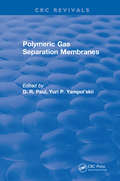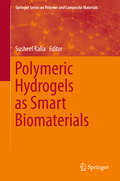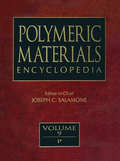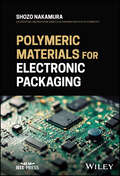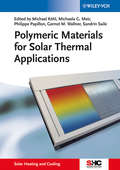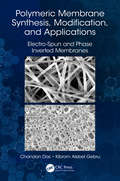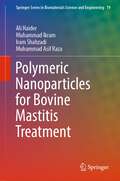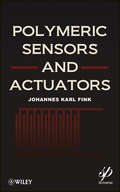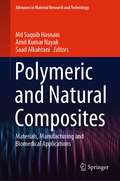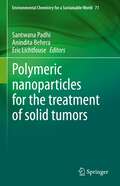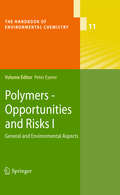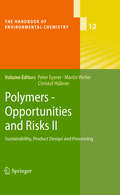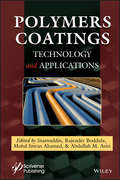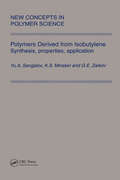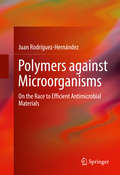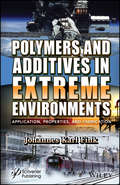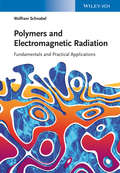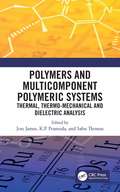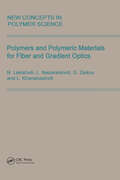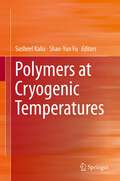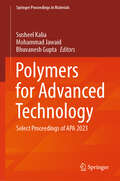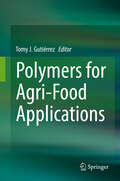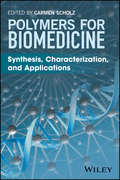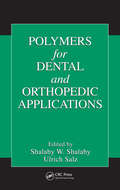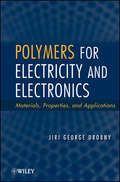- Table View
- List View
Polymeric Gas Separation Membranes
by D.R. PaulPolymeric Gas Separation Membranes is an outstanding reference devoted to discussing the separation of gases by membranes. An international team of contributors examines the latest findings of membrane science and practical applications and explores the complete spectrum of relevant topics from fundamentals of gas sorption and diffusion in polymers to vapor separation from air. They also compare membrane processes with other separation technologies. This essential book will be valuable to all practitioners and students in membrane science and technology.
Polymeric Hydrogels as Smart Biomaterials
by Susheel KaliaThis book is concerned with polymeric hydrogels, which are considered as one of the most promising types of new polymer-based materials. Each chapter in this book describes a selected class of polymeric hydrogels, such as superabsorbent hybrid nanohydrogels, conducting polymer hydrogels, polysaccharide-based or protein-based hydrogels, or gels based on synthetic polymers. In this way, the book also addresses some of the fascinating properties and applications of polymeric hydrogels: they are three-dimensional, hydrophilic, polymeric networks that can absorb, swell and retain large quantities of water or aqueous fluids. In combination with metal nanoparticles, nanofibrils or nanowhiskers, which may be embedded in the gels, they find widespread applications, ranging from agriculture, and waste water treatment, over electronics, to pharmaceutical and biomedical applications. Applications mentioned in this book include electro sensors, capacitors, electromechanical actuators, and even artificial muscles.
Polymeric Materials Encyclopedia, Twelve Volume Set
by Joseph C. SalamoneThe Polymeric Materials Encyclopedia presents state-of-the-art research and development on the synthesis, properties, and applications of polymeric materials. This groundbreaking work includes the largest number of contributors in the world for a reference publication in polymer science, and examines many fields not covered in any other reference. With multiple articles on many subjects, the encyclopedia offers you a broad-based perspective on a multitude of topics, as well as detailed research information, figures, tables, illustrations, and references. Updates published as new research unfolds will continue to provide you with the latest advances in polymer science, and will keep the encyclopedia at the forefront of the field well into the future.From novices to experienced researchers in the field, anyone and everyone working in polymer science today needs this complete assessment of the state of the art.The entire 12-volume set will be available in your choice of printed or CD-ROM format.
Polymeric Materials for Electronic Packaging
by Shozo NakamuraPOLYMERIC MATERIALS FOR ELECTRONIC PACKAGING Create and deploy reliable polymeric materials for use in electronic products with this comprehensive guide Modern electronic products are manufactured at a finer scale and with more precision than ever before. This places increasing demand on the proper use and management of high-performance polymers to create reliable, rapidly-operating semiconductor products. Understanding the physical properties and viscoelasticity analysis of resins is essential for engineers and researchers to perfect and deploy these polymers in electronics contexts. Polymeric Materials for Electronic Packaging is designed to meet this specific need with a thorough introduction to these materials and their production. It provides the tools engineers need to reduce processing times and increase durability in their semiconductor packages and products. Translated from the Japanese original and offering in-depth analysis from a global-leading expert, this promises to be an indispensable volume. Polymeric Materials for Electronic Packaging readers will also find: Detailed treatment of subjects including viscoelastic theory, design issues of LSI packages, and more Analysis uniquely suited to the dimensions of cutting-edge semiconductor technology Incorporation of cutting-edge viscoelasticity analysis software, available separately from the author Polymeric Materials for Electronic Packaging is critical for electrical and electronics engineers working with semiconductors, as well as advanced postgraduate students and researchers in this or numerous related areas.
Polymeric Materials for Solar Thermal Applications (Solar Heating And Cooling Ser.)
by Sandrin Saile Michaela Georgine Meir Philippe Papillon Michael Kühl Gernot Michael WallnerBridging the gap between basic science and technological applications, this is the first book devoted to polymers for solar thermal applications. Clearly divided into three major parts, the contributions are written by experts on solar thermal applications and polymer scientists alike. The first part explains the fundamentals of solar thermal energy especially for representatives of the plastics industry and researchers. Part two then goes on to provide introductory information on polymeric materials and processing for solar thermal experts. The third part combines both of these fields, discussing the potential of polymeric materials in solar thermal applications, as well as demands on durability, design and building integration. With its emphasis on applications, this monograph is relevant for researchers at universities and developers in commercial companies.
Polymeric Membrane Synthesis, Modification, and Applications: Electro-Spun and Phase Inverted Membranes
by Chandan Das Kibrom Alebel GebruMembranes and membrane separation techniques have grown from a simple laboratory tool to an industrial process with considerable technical and commercial impact. The book deals with both the fundamental concepts of preparation, characterization and modification, practical applications along with recent advancements of electro-spun and phase inverted polymeric membranes. Divided into two parts, part one of this book covers the fundamental concepts and practical applications of novel electro-spun membranes while the latter covers basic concepts and further advancements of the conventional phase inverted membranes extensively. <P><P>Key Features <li>Covers fundamental concepts and practical applications of electro-spun and phase inverted polymeric membranes <li>Includes general properties, characterization, preparation and modification of polymeric membranes <li>Discusses advanced modification of polymeric membranes (functionalization, grafting) using phase inversion process, and effects of solubility parameter and additives on the phase inversion process <li>Reviews electro-spun membranes for biomedical applications, industrial effluents treatment and removal of water contaminants <li>Explores a separate economic analysis section for the discussed membranes
Polymeric Nanoparticles for Bovine Mastitis Treatment (Springer Series in Biomaterials Science and Engineering #19)
by Muhammad Ikram Ali Haider Iram Shahzadi Muhammad Asif RazaThis book features an in-depth examination of the ongoing problem of bovine mastitis and the potential solutions offered by polymer nanoparticles. With extensive research and analysis, the book delves into the causes and consequences of bovine mastitis, including the shift in the relevance of various infections and the increasing problem of antibiotic resistance. The authors explore the use of nanoparticles as a potential alternative to traditional antibiotics and the importance of tailoring their characteristics for specific uses. Detailed discussions of the pros and cons of different manufacturing procedures and characterizations of bovine mastitis, drug-resistant bacteria, and resistance development make this monograph an invaluable resource for researchers and experts in the field of veterinary medicine, and an excellent resource for those interested in investigating the viability of nano-materials as future antibiotic alternatives.
Polymeric Sensors and Actuators
by Johannes Karl FinkThis book covers in-depth the various polymers that are used for sensors and actuators from the vantage point of organic chemistry. Since many chemists may not be familiar with the physics and operational specifics of sensors, the book has a general chapter dealing with the overall physics and basic principles of sensors. Also included are methods of fabrication, as well as information on smart textiles, actuators, and the processing of data. The range of sensors covered include humidity, temperature, chemical, mechanical, optical, electrode, electronic nose, switchable devices, biosensors, and others.
Polymeric and Natural Composites: Materials, Manufacturing and Biomedical Applications (Advances in Material Research and Technology)
by Amit Kumar Nayak Md Saquib Hasnain Saad AlkahtaniThis book provides understanding of raw materials, manufacturing and biomedical applications of different polymeric and natural composites such as drug delivery, growth factor delivery, orthopedics, dentistry and wound dressing.
Polymeric nanoparticles for the treatment of solid tumors (Environmental Chemistry for a Sustainable World #71)
by Eric Lichtfouse Santwana Padhi Anindita BeheraThis book focuses on the emerging research in the field of treatment of solid tumors or cancer with new drug delivery systems using nanotechnology. Nanotechnology has given us a good scope for development of new innovative drug delivery strategies to increase the therapeutic efficacy of anticancer drugs with reduced off-target side effects. Cancer is one of the main causes of death worldwide due to the limitations of classical therapies such as low solubility of active drugs, toxic side effects on healthy cells and resistance of tumor cells. These issues are partly solved by the recent development of polymeric nanoparticles, which improve drug absorption and the therapeutic index, while reducing side effects. Drug carriers must be biocompatible, biodegradable and non-immunogenic. Coupled to a ligand that has affinity for that particular cell, polymeric nanoparticles are used to target specifically malignant cells or tissues and, in turn, improve drug stability. This book presents the latest advances in the application of polymeric particles for cancer treatment, with focus on the tumor microenvironment, synthesis, active and passive targeting, patents, targeting over-expressed receptors, tumor-targeting ligands, theranostics, glioblastoma tumors, lung cancer, breast cancer, prostate cancer and pH-responsive nanoparticles
Polymers - Opportunities and Risks I
by Peter EyererSince their first industrial use polymers have gained a tremendous success. The two volumes of "Polymers - Opportunities and Risks" elaborate on both their potentials and on the impact on the environment arising from their production and applications. Volume 11 "Polymers - Opportunities and Risks I: General and Environmental Aspects" is dedicated to the basics of the engineering of polymers - always with a view to possible environmental implications. Topics include: materials, processing, designing, surfaces, the utilization phase, recycling, and depositing. Volume 12 "Polymers - Opportunities and Risks II: Sustainability, Product Design and Processing" highlights raw materials and renewable polymers, sustainability, additives for manufacture and processing, melt modification, biodegradation, adhesive technologies, and solar applications. All contributions were written by leading experts with substantial practical experience in their fields. They are an invaluable source of information not only for scientists, but also for environmental managers and decision makers.
Polymers - Opportunities and Risks II
by Peter Eyerer Christof Hübner Martin WellerSince their first industrial use polymers have gained a tremendous success. The two volumes of "Polymers - Opportunities and Risks" elaborate on both their potentials and on the impact on the environment arising from their production and applications. Volume 11 "Polymers - Opportunities and Risks I: General and Environmental Aspects" is dedicated to the basics of the engineering of polymers - always with a view to possible environmental implications. Topics include: materials, processing, designing, surfaces, the utilization phase, recycling, and depositing. Volume 12 "Polymers - Opportunities and Risks II: Sustainability, Product Design and Processing" highlights raw materials and renewable polymers, sustainability, additives for manufacture and processing, melt modification, biodegradation, adhesive technologies, and solar applications. All contributions were written by leading experts with substantial practical experience in their fields. They are an invaluable source of information not only for scientists, but also for environmental managers and decision makers.
Polymers Coatings: Technology and Applications
by Abdullah M. Asiri Mohd Imran Ahamed Rajender Boddula InamuddinThe explores the cutting-edge technology of polymer coatings. It discusses fundamentals, fabrication strategies, characterization techniques, and allied applications in fields such as corrosion, food, pharmaceutical, biomedical systems and electronics. It also discusses a few new innovative self-healing, antimicrobial and superhydrophobic polymer coatings. Current industrial applications and possible potential activities are also discussed.
Polymers Derived from Isobutylene. Synthesis, Properties, Application
by G.E. Zaikov Yu.A. Sangalov K.S. MinskerThis monograph aims to give an overview of recent chemical and technological developments in the area of polymers and co-polymers derived from isobutylene, which have a wide range of (industrial) applications.The scientific basis for presenting the material aEURO" application of the acid-base theory with a view to the fundamental steps of isobutylene polymerization aEURO" is combined with the application of quantum-chemical calculations of catalysts, linked active centers, separate elementary stages of the process, and critical analysis of some experimental data. In addition, a number of problems, such as the macrokinetic description of isobutylene polymerization, description of the balanced scheme of industrial production of isobutylene polymers, and initiation of isobutylene polymerization with the help of immobilized cationic catalysts are discussed. Special attention is given to ecological aspects of synthesis and application of isobutylene polymers.This book will be of value and interest to researchers in the areas of chemistry and physics of high-molecular compounds, as well as engineers and technologists specialized in the area of olefins and polyolefins.
Polymers against Microorganisms
by Juan Rodríguez-HernándezThis book provides an introductory and general overview of advances in polymers towards their employment as antimicrobial materials. The author describes current approaches for avoiding microbial contamination, toward macro-molecular antibiotics, and prevention of antibiotic-resistant bacteria by use of polymers. He establishes the remaining issues and analyzes existing methodologies for treating bacterial infections and for preparing antimicrobial materials.
Polymers and Additives in Extreme Environments: Application, Properties, and Fabrication
by Johannes Karl FinkThe book includes chapters on aqueous environments including polymeric membranes for water purification and wastewater treatment; extreme pressure environments such as oils and lubricants for combustion engines as well as materials used for deep drilling such as surfactants, scale inhibitors, foaming agents, defoamers, proppants, fracturing fluids; extreme temperatures is subdivided in high and low temperature applications including gasketing materials, fuel tank sealants, expulsion bladders, fuel cell materials, and on the other hand, cold weather articles and thermoregulatory textiles; electrical applications include solar cell devices, triboelectric generators, fuel cell applications, electrochromic materials and batteries; medical applications include polymers for contact lenses, materials for tissue engineering, sophisticated drug delivery systems; aerospace applications include outer space applications such as low temperature and pressure, also cosmic rays, outgassing, and atomic erosion, as well as materials for electrostactic dissipative coatings and space suits; a final chapter detailing materials that are used in other extreme environments, such as adhesives, and polymeric concrete materials.
Polymers and Electromagnetic Radiation
by Wolfram SchnabelThis first book to cover the interaction of polymers with radiation from the entire electromagnetic spectrum adopts a multidisciplinary approach to bridge polymer chemistry and physics, photochemistry, photophysics and materials science.The text is equally unique in its scope, devoting equal amounts of attention to the three aspects of synthesis, characterization, and applications. The first part deals with the interaction of polymers with non-ionizing radiation in the frequency-range from sub-terahertz via infrared radiation to visible and ultraviolet light, while the second covers interaction with ionizing radiation from the extreme ultraviolet to ?-ray photons. The result is a systematic overview of how both types of radiation can be used for different polymerization approaches, spectroscopy methods and lithography techniques.Authored by a world-renowned researcher and teacher with over 40 years of experience in the field, this is a highly practical and authoritative guide.
Polymers and Multicomponent Polymeric Systems: Thermal, Thermo-Mechanical and Dielectric Analysis
by Sabu Thomas Jose James Pramoda Kumari PallathadkaIn recent years, multicomponent polymers have generated much interest due to their excellent properties, unique morphology and high-end applications. Book focusses on thermal, thermo-mechanical and dielectric analysis of polymers and multicomponent polymeric systems like blends, interpenetrating polymeric networks (IPNs), gels, polymer composites, nanocomposites. Through these analyses, it provides an insight into the stability of polymer systems as a function of time, processing and usage. Aimed at polymer chemists, physicists and engineers, it also covers ASTM /ISO and other standards of various measurement techniques for systematic analysis in materials science.
Polymers and Polymeric Materials for Fiber and Gradient Optics
by Gennady Zaikov L. Nadareishvili N. Lekishvili L. KhananashviliThis book considers general aspects of the theory of polymers applied in optics. The main factors affecting the light loss in polymeric wave beam guides (PG) are discussed, and the mechanism of light loss in PG is analysed. Polymers applied in fiber optics are classified with reference to methods of fabrication and purification of the materials. Technological aspects of material fabrication are considered together with kinetic aspects of polymerisation. Updated information on polymerisation kinetics of MMA and styrene, and copolymerisation of these monomers with each other is reported. Other topics discussed in the book are heterogeneity of optic copolymers, association between structure and reactivity of monomers, other properties of optic copolymers, and areas of their commercial application. This volume will be of value and interest to anyone working in the field of optic polymers, both in academia and industry.
Polymers at Cryogenic Temperatures
by Susheel Kalia Shao-Yun FuKalia and Fu's novel monograph covers cryogenic treatment, properties and applications of cryo-treated polymer materials. Written by numerous international experts, the twelve chapters in this book offer the reader a comprehensive picture of the latest findings and developments, as well as an outlook on the field. Cryogenic technology has seen remarkable progress in the past few years and especially cryogenic properties of polymers are attracting attention through new breakthroughs in space, superconducting, magnetic and electronic techniques. This book is a valuable resource for researchers, educators, engineers and graduate students in the field and at technical institutions.
Polymers for Advanced Technology: Select Proceedings of APA 2023 (Springer Proceedings in Materials #1)
by Susheel Kalia Mohammad Jawaid Bhuvanesh GuptaThis book presents select proceedings of the International Conference on Polymers for Advanced Technology (APA 2023). Polymers offer enormous opportunities for newer applications in technologically important areas. This book includes comprehensive step-by-step chapters with details of the processing and functionalization of polymers and their applications. This book will help the readers to know the recent developments and comprehensive research on polymers for advanced technology. All chapters in this book include illustrations, tables, figures, graphs, bibliographies, and extensive references to provide comprehensive information to the readers. This book can be a valuable reference for researchers and professionals interested in polymeric materials and biomaterials.
Polymers for Agri-Food Applications
by Tomy J. GutiérrezThis book presents an exhaustive analysis of the trends in the development and use of natural and synthetic polymer systems aimed at sustainable agricultural production. The polymers have allowed the development of controlled and released systems of agrochemicals such as pesticides, fertilizers and phytohormones through micro and nanoencapsulated systems, which protect and stimulate the growth of crops at low costs and without damage to the environment. Hydrogel systems from natural and synthetic polymers have also had their place in the agricultural industry, since they allow to maintain the humidity conditions of the crops for their correct development in drought times. Mulch films made of polymers have also become important in the control of weeds and pests in crops, as well as the use of edible coatings applied to fruits and vegetables during post-harvest, which reduce the losses of these perishable foods. Currently, the systems indicated, as well as others, are already used on a large scale. However, research studies in this area have been limited compared to other polymer applications. This book collects useful information for researchers, students and technologies related to the polymer technology and agri-food production. In this book, world-renowned researchers have participated, including associate editors of important journals, as well as researchers working in the area of research and development (R&D) of leading agri-food industries in the manufacture of agricultural inputs.
Polymers for Biomedicine: Synthesis, Characterization, and Applications
by Carmen ScholzHighlighting dynamic developments in polymer synthesis, this book focuses on the chemical techniques to synthesize and characterize biomedically relevant polymers and macromolecules.• Aids researchers developing polymers and materials for biomedical applications• Describes biopolymers from a synthetic perspective, which other similar books do not do• Covers areas that include: cationically-charged macromolecules, pseudo-peptides, polydrugs and prodrugs, controlled radical polymerization, self-assembly, polycondensates, and polymers for surface modification
Polymers for Dental and Orthopedic Applications
by Shalaby W. Shalaby Ulrich SalzRecent advances not only in the creation of new polymers but also in their processing and production have ushered in huge strides in a variety of biomedical and clinical areas. Orthopedics and dentistry are two such areas that benefit immensely from developments in polymer science and technology. Polymers for Dental and Orthopedic Applications
Polymers for Electricity and Electronics
by Jiri George DrobnyThe comprehensive, practical book that explores the principles, properties, and applications of electrical polymersThe electrical properties of polymers present almost limitless possibilities for industrial research and development, and this book provides an in-depth look at these remarkable molecules. In addition to traditional applications in insulating materials, wires, and cables, electrical polymers are increasingly being used in a range of emerging technologies.Presenting a comprehensive overview of how electrical polymers function and how they can be applied in the electronics, automotive, medical, and military fields, Polymers for Electricity and Electronics: Materials, Properties, and Applications presents intensive and accessible coverage with a focus on practical applications. Including examples of state-of-the-art scientific issues, the book evaluates new technologies--such as light emitting diodes, molecular electronics, liquid crystals, nanotechnology, optical fibers, and soft electronics--and explains the advantages of conductive polymers as well as their processibility and commercial uses.This book is an essential resource for anyone working with, or interested in, polymers and polymer science. In addition, appendices that detail the electrical properties of selected polymers as well as list additional ASTM and corresponding international testing standards and methods for testing electrical properties are also included.
